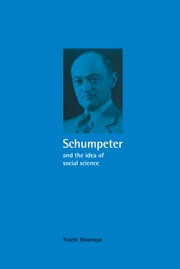Book contents
- Frontmatter
- Contents
- List of figures
- Preface
- 1 Introduction
- 2 Schumpeter and his surroundings: an overview
- 3 The scope and methods of Schumpeter's research program
- 4 The sociology of science and Schumpeter's ideology
- 5 The economic methodology of instrumentalism
- 6 Static economics as an exact science
- 7 The theory of economic development as a midpoint
- 8 A methodology of economic sociology
- 9 Economic sociology as an evolutionary science
- 10 The historical world of economics
- 11 Value judgments and political economy
- 12 Conclusion: Schumpeterian synthesis
- Notes
- List of references
- Index
12 - Conclusion: Schumpeterian synthesis
Published online by Cambridge University Press: 18 September 2009
- Frontmatter
- Contents
- List of figures
- Preface
- 1 Introduction
- 2 Schumpeter and his surroundings: an overview
- 3 The scope and methods of Schumpeter's research program
- 4 The sociology of science and Schumpeter's ideology
- 5 The economic methodology of instrumentalism
- 6 Static economics as an exact science
- 7 The theory of economic development as a midpoint
- 8 A methodology of economic sociology
- 9 Economic sociology as an evolutionary science
- 10 The historical world of economics
- 11 Value judgments and political economy
- 12 Conclusion: Schumpeterian synthesis
- Notes
- List of references
- Index
Summary
Schumpeter was once depicted by George Stigler as: “immensely learned and immensely clever, and as a minor foible, a poseur in abstract economic theory” (Stigler 1988, 100). Even if Stigler is partly right, it is far more important to recognize the great possibilities of Schumpeter's alleged “minor foible.” By acting as if he were an abstract economic theorist, Schumpeter left large-scale heterodox concepts that would never have been formulated by ordinary theoretical economists.
Vision and theory construction
One of Schumpeter's greatest torments in the academic world was probably the gap between his vision and his construction of theory. His original ideas, such as technological innovation, long swings, monopolistic firms, dynamic competition, and evolutionary economics, which were offered from a dynamic point of view, were not fully developed by him, but they were recognized by later economists as highly relevant themes and led to prolific results in the fields of theoretical and empirical analysis. These themes helped broaden the frontier of economics.
In later years Schumpeter wrote: “The highest ambition an economist can entertain who believes in the scientific character of economics would be fulfilled as soon as he succeeded in constructing a simple model displaying all the essential features of the economic process by means of a reasonably small number of equations connecting a reasonably small number of variables” (1946c, 3).
- Type
- Chapter
- Information
- Schumpeter and the Idea of Social ScienceA Metatheoretical Study, pp. 306 - 312Publisher: Cambridge University PressPrint publication year: 1997



